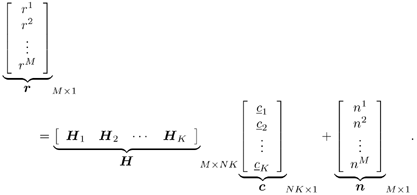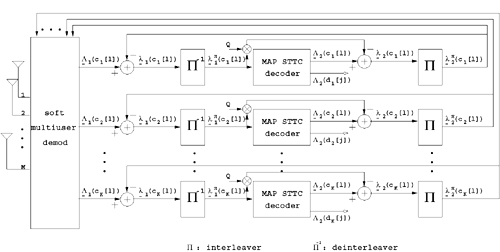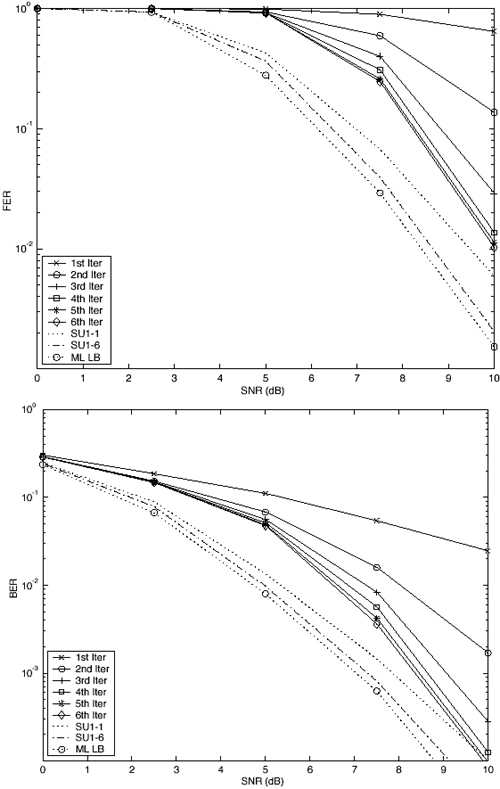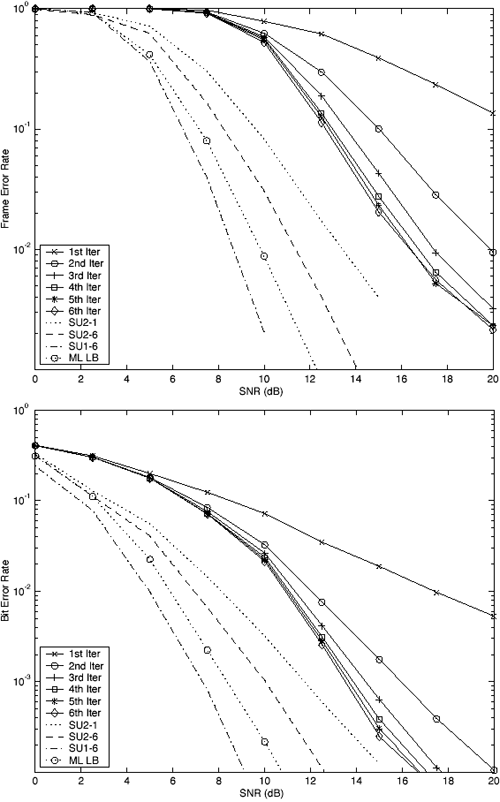6.8 Turbo Multiuser Detection in Space-Time Trellis-Coded Systems
6.8 Turbo Multiuser Detection in Space-Time Trellis -Coded SystemsIn Section 6.7 we developed an iterative receiver structure for multiuser STBC systems based on the turbo multiuser detection technique. In this section we apply the same ideas to multiuser space-time trellis-coded (STTC) systems. Moreover, by exploiting the intrinsic structures of STTC, we consider a more compact system without introducing any outer channel code. 6.8.1 Multiuser STTC System An STTC is basically a TCM code, which can be defined in terms of a trellis tree. The input to the encoder at time t is the k -dimensional binary vector d t = ( In what follows we discuss a multiuser STTC communication system that employs a turbo receiver structure. The transmitter end of the proposed multiuser STTC system is depicted in Fig. 6.26. Note that there is a complex symbol inter-leaver between the STTC encoder and the multiple transmitter antennas for each user. Such an interleaver is the key to reducing the influence of error bursts at the input of each user's MAP STTC decoder. Figure 6.26. Transmitter structure for a multiuser STTC system. For the multiuser STTC system, the channel model is similar to (6.185), except that matrix-based temporal constraints no longer exist. We have the following system model for the multiuser STTC system: Equation 6.207 In (6.207), r m , m = 1, 2, . . . , M , is the received signal at the m th receiver antenna; H k , k = 1, 2, . . . , K , is the channel response matrix for the k th user; the ( m, n )th element of H k is the fading gain from the n th, n = 1, 2, . . . , N , transmitter antenna to the m th, m = 1, 2, . . . , M , receiver antenna of the k th user; Comparing (6.185) and (6.207), the key differences between the STBC and STTC systems are as follows:
6.8.2 Turbo Multiuser Receiver for STTC System The turbo receiver structure for a multiuser STTC system is illustrated in Fig. 6.27. It consists of a soft multiuser demodulator, followed by K parallel MAP STTC decoders. The two stages are separated by interleavers and deinterleavers. The soft multiuser demodulator takes as input the received signals from the M receiver antennas and the interleaved extrinsic log probabilities (LPs) of the complex code symbols (i.e., { l 2 ( c k [ l ])} i;k , which are fed back by the K single-user MAP STTC decoders), and computes as output the a posteriori LPs of the complex code symbols { L 1 ( c k [ l ])} i;k . The MAP STTC decoder of the k th user takes as input the deinterleaved extrinsic LPs of complex code symbols { l 1 ( Figure 6.27. Iterative receiver structure for a multiuser STTC system. Soft Multiuser DemodulatorIn terms of algorithmic operations, the soft multiuser demodulator for the STTC system (6.207) is exactly the same as that discussed in Section 6.7.2. However, since the system (6.185) contains both the information about the channel and the STBC temporal constraints, the soft multiuser demodulator for the multiuser STBC system decodes the STBC code words of all users by estimating the code symbols of all users (which is realized implicitly through the instantaneous MMSE filtering of virtual users' signals in Section 6.7.2). By contrast, the system (6.207) contains only the information about the channel, and therefore the soft multiuser demodulator for the multiuser STTC system estimates only the code symbols of all users, and each user needs to apply the MAP decoder further to decode its STTC. Computing a posteriori Code Symbol LPs The output of the soft multiuser demodulator is a soft estimate with Equation 6.208 where the index [ l, i ] denotes the i th element in the W c -dimensional LP vector for the l th code symbol. Note that Equation 6.209 At the output of the soft multiuser demodulator, the i th element of the a posteriori LP vector for code symbol c [ l ] is computed as Equation 6.210 where log p ( Equation 6.211 In (6.211), Q is a coefficient and will be discussed later. At the first iteration, no prior information about code symbols is available; thus l 2 ( c [ l, i ]) = log 1/ W c , i = 1, 2, ..., W c . It is seen from (6.210) that the output of the soft multiuser demodulator is the sum of the a priori information l 2 ( c [ l, i ]) provided by the MAP STTC decoder in the previous iteration and the extrinsic information l 1 ( c [ l, i ]). Finally, the extrinsic LPs, calculated in (6.210), are deinterleaved and then fed to the MAP STTC decoder. Note that at the STTC multiuser receiver side, the interleavers/deinterleavers perform interleaving/deinterleaving on the LP vectors rather than on the elements of the LP vector. MAP Decoding Algorithm for STTC The MAP STTC decoding algorithm is very similar to the MAP decoding algorithm for the convolutional code except for some minor modifications. For the sake of conciseness, we omit the derivation of the MAP STTC decoding algorithm here. Similar to our work in Section 6.7.2, we partition the deinterleaved extrinsic LP's stream { l 1 ( c p [ l ])} l into blocks, with each block consisting of n code symbol LP vectors, corresponding to the n output code symbols at one time instant. This reorganized code symbol LP stream is denoted as Finally, based on the interleaved extrinsic LP vector l 2 ( c [ l ]) of the l th code symbol, the soft estimated Equation 6.212 At the first iteration, no prior information is available; thus l 2 ( c [ l, i ]) = log 1/ W c . At the last iteration, the information bits are recovered by the MAP algorithm. Projection-Based Soft Multiuser DemodulatorThe projection operation involves processing only the spatial information that is contained in the channel response matrix H in (6.207). Therefore, in terms of algorithmic operations, the projection-based soft multiuser demodulator for the STTC system is exactly the same as that discussed for STBC in Section 6.7.2. Simulation ExamplesWe consider a four-user ( K = 4) STTC system, as shown in Fig. 6.26. Each user employs the same 8-PSK eight-state STTC, as defined in Fig. 7 in [477], and two transmitter antennas ( N = 2). The STTC encoder is forced to the all-zero state at the end of every signal frame, where each frame contains 128 8-PSK code symbols. At the receiver side, eight antennas ( M = 8) are used. Assume that all K users' signals are to be decoded ( K = 4). The performance of the turbo receiver discussed in Section 6.8.2 is shown in Fig. 6.28. In computing the extrinsic code symbol information obtained from the MAP STTC decoder, we have introduced a scaling factor Q (cf. Fig. 6.27), which takes the same value between 0 and 1 for all users. In our simulations we find that in STTC systems, introducing such as Q factor significantly improves the performance of the iterative receiver. (The best performance is achieved for Q Figure 6.28. Frame-error rate (FER) and bit-error rate (BER) for a four-user STTC system. K = 4, N = 2, M = 8, Q = 0.85. All four users are iteratively detected and decoded. SU1-1 and SU1-6 denote the iterative decoding performance of the single-user system with K = 1, N = 2, M = 8, Q = 0.85. MLLB denotes the optimal single-user performance with K = 1, N = 2, M = 8. As before, the dotted lines (denoted as SU1-1 ) and the dash-dotted lines (denoted as SU1-6 ) in Figs. 6.28 and 6.29 represent, respectively, the iterative decoding performance after the first and sixth iterations in a single-user system ( N = 2, M = 8). In contrast to the STBC system, the STTC system proposed does not include the outer channel code; therefore, the optimal single-user STTC receiver is straightforward to implement [477]. We also include its performance (in circle-dotted lines and denoted as MLLB ) in Figs. 6.28 and 6.29. Similarly as in STBC systems, it is seen that the performance of the iterative receiver is significantly improved compared with that of the noniterative receiver, and it approaches the optimal single-user performance as well as the single-user iterative decoding performance. We next consider the performance of the projection-based turbo receiver. Assume that K d out of all K users' signals are to be decoded ( K = 4, K d = 2). In this scenario, two users are first nulled out by a projection operation, and the other two users are iteratively detected and decoded. The performance is shown in Fig. 6.29. Again the dotted lines (denoted as SU2-1 ) and the dash-dashed lines (denoted as SU2-6 ) in this figure represent, respectively, the single-user iterative decoding performance ( N = 2, M' = 4) after the first and sixth iterations. As in STBC systems, it is seen that the projection operation incurs a substantial performance loss compared with the turbo receiver operating on all users in the STTC system. Hence it is the best to avoid the use of such a projection operation whenever possible in order to achieve optimal performance. Figure 6.29. Frame-error rate (FER) and bit-error rate (BER) for a four-user STTC system. K = 4, N = 2, M = 8, M' = 4, Q = 0.85. Two users are first nulled out; the other two users are iteratively detected and decoded. SU2-1 and SU2-6 denote the iterative decoding performance of the single-user system with K = 1, N = 2, M' = 4, Q = 0.85. MLLB denotes the optimal single-user performance with K = 1, N = 2, M' = 4. The gap between SU1-6 and SU2-6 constitutes the diversity loss caused by the projection operation. |
EAN: 2147483647
Pages: 91






 0.85.) Interestingly, we have found that for STBC systems, such a scaling factor does not offer performance improvement.
0.85.) Interestingly, we have found that for STBC systems, such a scaling factor does not offer performance improvement. 
